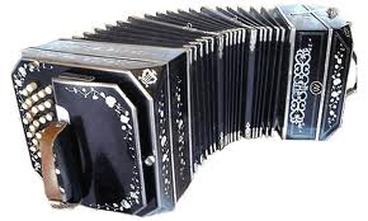The Bandoneon
|
The bandoneon was developed by Heinrich Band from the German concertina. The instrument has exceptional long bellows, that, so to speak, are "broken" on the knee of the musician in order to obtain strong accents. The sound of the bandoneon is very warm, this makes it very suitable for playing melancholic music.
The big difference between a bandoneon and e.g. an accordeon is that every button has a seperate tone, instead of the chord-possibility at the left side. A bandoneon is bisonic (different tone in push and draw), but there also do exist unisonic types. Because of this and the layout of the buttons, it is not an easy instrument to play. |
The left and right hand layouts are also different, this adds up to four different keyboard layouts that must be learned in order to play the instrument. But there is the advantage that notes tend to progress from the bass clef on the left hand to above the treble clef on the right. In 1924 the number and positions of the buttons were standardised to include 72 buttons that cover a five octave range. The layouts of the buttons are not structured to facilitate playing scale passages of single notes, but to aid the playing of chords. The many handcraft also makes every bandoneon unique.
|
The bandoneon was originally intended for religious and popular music of the day. At the end of the 19th - beginning of the 20th century, the instrument was very popular in Germany, but due to nazism, world war II and the increasing popularity of the accordeon, it passed into disuse.
It has been said that Thomas Moore, from Ireland, introduced the bandoneon in Argentina. Yet it is most likely that German sailors and Italian seasonal workers and emigrants brought it with them in the late 19th century. In Argentina the bandoneon became one of the most popular instruments. It was adopted into the milonga music at that time. The style that sprang from the milonga is the modern tango music. The bandoneon developed to the typical instrument of the Argentine tango, with A. Piazolla as best know bandoneon player |
It was the German factory of Alfred Arnold in Carlsfeld that met the growing demand for the bandoneon. Especially the types "Doble - A" and "Premier" were popular and it was said that only Alfred Arnold knew the secret.
Sources: en.wikipedia.org; nl.wikipedia.org; www.music.vt.edu/MUSICDICTIONARY/textb/Bandoneon.html
Sources: en.wikipedia.org; nl.wikipedia.org; www.music.vt.edu/MUSICDICTIONARY/textb/Bandoneon.html


